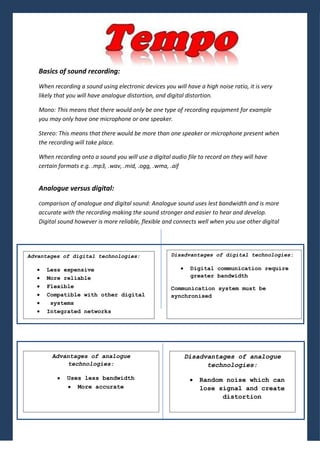Draft
- 1. Basics of sound recording: When recording a sound using electronic devices you will have a high noise ratio, it is very likely that you will have analogue distortion, and digital distortion. Mono: This means that there would only be one type of recording equipment for example you may only have one microphone or one speaker. Stereo: This means that there would be more than one speaker or microphone present when the recording will take place. When recording onto a sound you will use a digital audio file to record on they will have certain formats e.g. .mp3, .wav, .mid, .ogg, .wma, .aif Analogue versus digital: Comparison of analogue and digital sound: Analogue sound uses lest bandwidth and is more accurate with the recording making the sound stronger and easier to hear and develop. Digital sound however is more reliable, flexible and connects well when you use other digital Disadvantages of digital technologies: Digital communication require greater bandwidth Communication system must be synchronised Advantages of analogue technologies: Uses less bandwidth More accurate Disadvantages of analogue technologies: Random noise which can lose signal and create distortion Advantages of digital technologies: Less expensive More reliable Flexible Compatible with other digital systems Integrated networks
- 2. Applications: Interactive media products CD- This is a compact disc which stores information; it can store items such as music or pictures. It was first developed to play back sound recordings but was after adapted to store data. The data on the CD can be something such as Music this music can be used in any device that would allow a cd to be played, the music on the device can be anything that is downloadable. This is mainly used for entertainment but can be used to transfer important music files or photos; DVD interface- Within the media there is a concept in which two components; this can be conducted by using something small like an SD card or something as big as the internet. The data can be used to hold music, photos or moving images and can be played in any device that is DVD compatible. This is mainly used for entertainment but in some cases can be used to transfer important data. Television- This is a telecommunication device in which you can transmit moving images or sound recordings such as radio. The sound recordings used on a telecommunication device can show the emotion of the characters in the television show, for example if the character in the TV show is sad, sad music will be played to show that the character is sad. Mobile phone content- This is a device that can be used to make and receive phone calls, this is a device that uses the sound waves across a signaled path so that the person on the other end of the phone line can hear what the first person is saying. Theory of sound Waveform Pitch- Pitch is where the ordering of the sound is related on the frequency scale. Pitches are compared as âhigherâ and âlowerâ Pitch is a major attribute of musical tones, duration, and loudness. Decibel level (dB)-The decibel (DB) is a unit that indicated the ratio of quantity. A decibel is one tenth of a bell. Sound generator (loudspeaker) Frequency and pitch The rate at which a sound wave moves is called the frequency. Frequency is measured Hz. The length of a single cycle of a waveform is the span of time it takes for that waveform to repeat.

